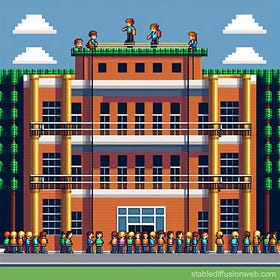This functions as an index post for my series on designing a school.
Part 1: School as Social Services
Let's Design A School, Part 1
The American school system, grades K-12, leaves much to be desired. While its flaws are legion, this post isn’t about that. It’s easy to complain. This post is about how we could do better. To be clear, I’m talking about redesigning public education, so “just use the X model” where X is “
Part 2: School as Education
Let's Design A School, Part 2.1
What are our goals when it comes to school-as-education? What are we actually trying to achieve? It’s my understanding that the current school system is designed to produce factory workers - that is, to create a class of adults capable of working productively in a factory. In that context, many aspects of education that used to confuse me become obvious.
Let's Design A School, Part 2.2
The problem you run into when designing a curriculum is that you have to decide what you want students to learn. The problem with deciding what you want students to learn is that your decisions will inevitably end up being a reflection of your values. It isn’t a task that can be done objectively.
Let's Design A School, Part 2.3
In the previous post, we outlined three phases that students would go through, where each student matriculated through them at their own speed. Phase 1 was literacy and numeracy. Phase 2 was core civilizational requirements and survey courses. Phase 3 was core adulting requirements and self-study.
Let's Design A School, Part 2.4
In previous posts, we laid out our model of school-as-education: Phase 1 was literacy and numeracy, Phase 2 was core civilizational requirements and survey courses, Phase 3 was core adulting requirements and self-study, and went into detail about the core civilizational requirements of phase 2.
Part 3: The Sieve Model
Let's Design A School, Part 3.1
In part 1, we laid out the social services model of a school. In part 2, we described a new educational model of a school. In part 3, we’re going to combine them. Different Schools, Different Problems The hardest part of designing a public school is that you’re trying to create a one-size-fits-all solution to an array of vastly different problems.
Let's Design a School, Part 3.2
We’ve established our hybrid model of school, where social services issues are addressed with a sieve model and education boils down to three phases. In part 1, we went through the expected costs for the school-as-social-services model. Now we’ll go through the costs for school-as-education, then we’ll discuss the costs of the full model.
Part 4: Discipline and Misc.
Let's Design a School 4.1
Some of the feedback that I’ve gotten on this new school system centers around a single topic - what should the school do with troublemakers? Keep in mind that the current school system doesn’t do a great job with these students either - we’re not trying to beat a high bar.










